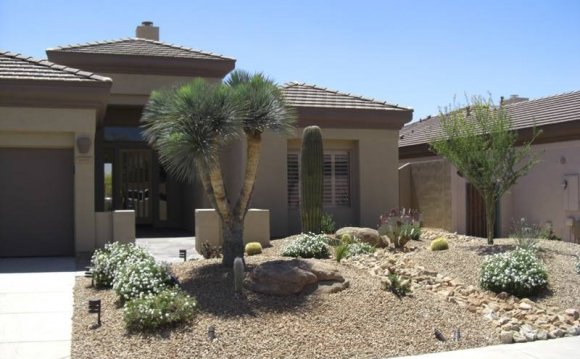
Place big-money plants where they'll be most often seen. Rasmussen always uses large plants and striking plant combinations to mark a home's entryway. Whenever possible, he incorporates plants that offer multiseason interest, like the patch of prickly pear cactus (Opuntia) that flowers with yellow blooms through spring; the flowers give way to reddish fruits, and come winter, the paddles shade to purple. A pink-flowering Mexican oregano shrub (Lavender Spice Poliomintha) provides fragrance, flowers, and waxy evergreen foliage. A palm-treelike beaked yucca (Yucca rostrata) supplies a dramatic crowning touch.
Get Inspired by Your Home
Take your cue from your home's architecture and the surrounding landscape. This home was built atop a lava-rock field, so Rasmussen incorporated black lava rocks in borders stepping up the slopes framing the wide steps. He placed plants so their forms would draw the eye toward the front door; he also positioned plants away from the stairs so they wouldn't intrude on the upward view or poke guests.
On the left side of the stairs, a rocky point ice plant (Malephora lutea) and silvermound artemesia soften the base of the garden, while a gray desert spoon and purple-flowering verbena add interest to the midground. Yellow bird of paradise trees (Caesalpinia gilliesii), which grow 10 feet tall, frame the top of the steps. In late spring they bear yellow blooms that attract hummingbirds. At the very top on the right, Rasmussen placed a giant sword flower (Hesperaloe funifera), a yucca-like plant that produces
Go with Appropriate Plants
Tired of hauling out the hose? Combine drought-tolerant plant varieties that can go long stretches without watering. Here, self-sustaining plants mirror the arched shape of a nearby stucco wall. Honey mesquite branches soften the foreground, while gray desert spoon (Dasylirion wheeleri) provides a contrasting vertical form and color behind shrubbier turpentine bush (Ericameria laricifolia) and creosote bush (Larrea tridentata). Like many desert plants, the two shrubs bear tiny leaves, which help plants retain moisture. If these plants won't grow where you live, get a desert look by incorporating small-leaf shrubs, such as potentilla or caryopteris, with plants with sword-like leaves, such as Adam's needle (Yucca filamentosa).
Add Architectural Interest
Stucco-walled raised beds show how desert plants can be combined to create more traditional gardens. "The idea here was to use plants to visually shorten the tall walls, " Rasmussen says. "So we planted trailing rosemary to spill over the upper walls and then planted vertical yuccas in the beds below to fill out the lower walls." Red-flowering yucca, a pink-blooming Mexican oregano shrub, and smoky-blue spires of Russian sage (Perovskia atriplicifolia) work in concert to brighten the upper tier. Pops of red emanate from dwarf oleanders (Nerium oleander), a mounding shrub with large clusters of blooms from spring into fall. Upright myrtle spurge (Euphorbia rigida), yellow-blooming paper flower (Psilostrophe tagetina), and pots of agave and yucca anchor the terraces.
If you live in areas where there's plentiful rainfall and high humidity, you can still create desertlike vignettes using plants suited to your region. Jeff Clark, a horticulturist at High Country Gardens in Santa Fe, recommends a sun-heated site with quick-draining soil; you'll find microclimates suited to xeriscape plants bordering west- and south-facing foundations, stone paths, rock walls, and in the "inferno strip" between sidewalk and street. Lighten soils with compost and coarse sand or crushed gravel. A good growing mix for xeric plants is 2 parts coarse sand to 1 part organic matter or soil topped with a gravel mulch.
Skip the Lawn
Instead of a water-hogging lawn, plant a desert garden suited to natural conditions. Rasmussen did just that across a client's front yard. He used a bed of chat and some strategically scattered lava rocks to tie the plantings with the adjoining landscape. Quick-growing clumps of Russian sage ably fill out the background, providing needed height and long-lasting color. Parry's century plant (Agave parryi) and yellow barrel cactus mix in varying forms and textures. Yellow-blooming desert marigolds (Baileya multiradiata) add splashes of sunshine amid the cacti and sage. They'll readily reseed themselves and naturalize among their companion plants.















